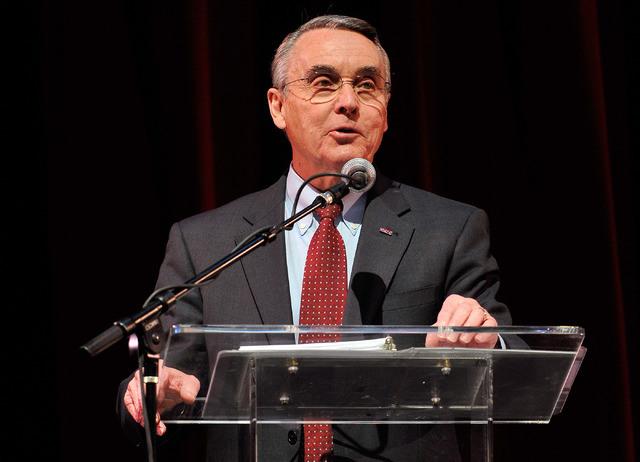UNLV deflates dream of domed stadium
Sixteen months ago, the University of Nevada, Las Vegas cut loose its campus stadium partner, Majestic Realty, to make peace with the Las Vegas resort industry.
The divorce meant abandoning a planned $900 million domed stadium.
It’s now clear that UNLV didn’t necessarily trade up.
Facing lukewarm support from the resorts, the university has shelved its desire for a dome, and instead is focusing on a more modest open-air stadium with capacity for 45,000 and sun shades somewhat like those at Baylor University’s new stadium.
The lesser stadium still supports UNLV’s aspiration to achieve Tier 1 status while keeping casino stakeholders at the table to support the stadium, Don Snyder, UNLV acting president and chairman of the UNLV’s 11-member stadium board, said Monday. The stadium panel is charged with sending a stadium report to the state Legislature by Sept. 30.
The stadium panel needs the resort industry on its side not only to contribute dollars to the project but also support public funding, Snyder said.
Stadium board member Rick Arpin, an MGM Resorts International finance executive, said Monday that Snyder has given the board draft resolutions indicating a preference for the open, shaded stadium.
“I have been consistent in thinking that a smaller, open-air stadium is the best option for UNLV for a variety of reasons, including cost and funding considerations, reasonable expectations of events and ensuring we build something that meets UNLV’s needs,” Arpin said.
UNLV stadium consultant Bill Rhoda, of Plano, Texas-based CSL, pegged the cost of the shaded stadium at about $523 million — the cheapest of three options outlined last week at a stadium board meeting.
Snyder said $100 million could be financed through stadium-generated revenues such as the sale of naming rights and suites. Snyder outlined the scaled-back plan and other options in one-on-one private meetings with board members earlier this month.
Snyder, along with Arpin, recently toured the new Baylor stadium and came away impressed with the facility.
Snyder faces a stiff challenge in building consensus on the stadium type. For example, Cedric Crear and James Dean Leavitt, two of the three Regents on the stadium panel, argue a domed stadium will attract more events and produce more revenue.
But Crear acknowledged that a dome is a long shot in light of resort industry opposition.
“It seems a strong contingent … of the board is for the stadium to be open air,” Crear said.
Crear and Leavitt have drawn push-back from resort industry representatives such as MGM’s Arpin, who said at a recent meeting that a domed stadium could “cannibalize” events from other Las Vegas venues. MGM and Anschutz Entertainment Group are building a 20,000-seat, $375 million arena near New York-New York, scheduled to open in 2016.
At the same meeting, Paul Chakmak of Boyd Gaming Corp. noted, “The resort industry is not asking for a stadium to be built.”
A Baylor-like shaded stadium would attract 11 annual non-UNLV football events and attendance of 372,000, while a closed venue would draw 21 annual events and attendance of 845,000, according to CSL. A domed stadium would attract two annual combat sport events such as boxing or MMA, while an open shaded stadium would draw none, the consultants said.
Leavitt said a domed stadium is a better investment. CSL estimates the cost of a domed venue at $832.6 million — more than $300 million more than a shaded stadium.
“For this to be justified, it has to be much more than a UNLV stadium and has to be a big-time domed stadium to serve the entire needs of southern Nevada,” Leavitt said. “At the end of the day, my proposal for a domed stadium is consistent with the resort industry needs, which is attracting tourists to Las Vegas during nontraditional times, specifically the summer.”
Gaming board members Kim Sinatra of Wynn Las Vegas, Sean McBurney of Caeser’s Entertainment and Chakmak could not be reached for comment Monday.
Under state law, the stadium board must complete a report addressing the need for a facility, what form it would take and how it would be funded. Several board members said if public dollars are needed a countywide sales tax is the way to go.
Contact reporter Alan Snel at asnel@reviewjournal.com or 702-387-5273. Follow @BicycleManSnel on Twitter.

















